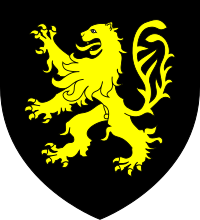
Sir John de Kingston (died after 1336) Lord of Kingston Bagpuize and Little Sutton was an English knight of the late 12th and early 13th centuries from Berkshire and Wiltshire. He fought in the wars in Wales, Flanders and Scotland. He was a signatory of the Baron's Letter to Pope Boniface VIII in 1301.
Biography
He served in Wales in 1277 under the command of the Earl of Lancaster. Kingston was in Wales in 1282 and in Flanders in 1297 on military service.
As one of King Edward I's leading commanders, he was Governor of Edinburgh Castle from 1298 to 1300 and from 1301 to at least 1305 (possibly as late as 1310). He was a signatory of the Baron's Letter to Pope Boniface VIII in 1301. John and his brother Nicholas were captured during the battle of Bannockburn on 24 June 1314. He was the Sheriff of Somerset from 1315 to 1317.
Kingston was known to be a member of the Earl of Lancaster's baronial revolt, known as the Despenser War, against King Edward II of England and fled abroad after the defeat of the Earl of Lancaster at the battle of Boroughbridge in 1322. He was forfeited and attainted. His lands were restored by 1329–30.
Following Edinburgh Castle's recapture by the English, in 1334 de Kingston was once again given charge of the castle.
He also held the offices of the Sheriff of Edinburgh and Senator of the College of Justice, during part of his lifetime.
He was succeeded by his son Thomas.
Notes
- Surname also spelt as Kyngeston, Kingeston, Kinggeston and Kinestone.
References
- Foster, Joseph (1994). The Dictionary of Heraldry. Feudal coats of arms and pedigrees. London: Studio Editions. p.122.
- Great Britain. Record Commission (1827), The parliamentary writs and writs of military summons : together with the records and muniments relating to the suit and service due and performed to the King's High court of Parliament and the Councils of the realm / collected and ed. by Francis Palgrave; Printed by command of His Majesty King George IV
- "Appendix: Governors and officers of the Castle | British History Online".
- Dunning, Robert (1983). A History of Somerset. Chichester: Phillimore & Co. pp. 109–117. ISBN 0-85033-461-6.
- 'Sutton Veny', in A History of the County of Wiltshire: Volume 8, Warminster, Westbury and Whorwellsdown Hundreds (London, 1965), pp. 61-74. British History Online http://www.british-history.ac.uk/vch/wilts/vol8/pp61-74 .
- Grant, Memorials of the Castle of Edinburgh, p. 280
- Chalmers, G (1902). "v. 8". Caledonia: Or, A Historical and Topographical Account of North Britain, from the Most Ancient to the Present Times with a Dictionary of Places Chorographical & Philological. Gardner. p. 164.
- Parishes: Kingston Bagpuize', in A History of the County of Berkshire: Volume 4, ed. William Page and P H Ditchfield (London, 1924), pp. 349-353. British History Online http://www.british-history.ac.uk/vch/berks/vol4/pp349-353
| Military offices | ||
|---|---|---|
| Preceded byWalter de Huntercombe | Constable of Edinburgh Castle 1298-1300 |
Succeeded byWilliam de Rue |
| VacantCastle slighted by Scots in 1314 | Constable of Edinburgh Castle 1334-?? |
Succeeded byJohn de Strivelyn |
| Honorary titles | ||
| Preceded byMatthew Furneaux | Sheriff of Somerset and Dorset 1316 |
Succeeded byNicholas Cheyney |